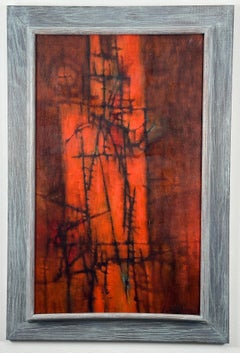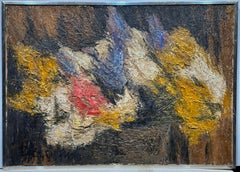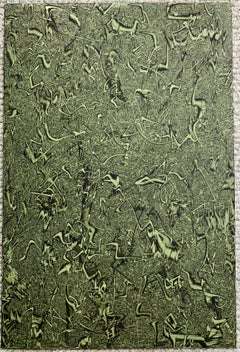Want more images or videos?
Request additional images or videos from the seller
1 of 9
Michael RossiUntitled (Abstract Expressionist collage oil painting)c.1960s
c.1960s
$1,500List Price
About the Item
- Creator:Michael Rossi (1920)
- Creation Year:c.1960s
- Dimensions:Height: 37 in (93.98 cm)Width: 25 in (63.5 cm)Depth: 2 in (5.08 cm)
- Medium:
- Movement & Style:
- Period:
- Condition:
- Gallery Location:Wilton Manors, FL
- Reference Number:1stDibs: LU24521518661
About the Seller
4.9
Platinum Seller
Premium sellers with a 4.7+ rating and 24-hour response times
Established in 2007
1stDibs seller since 2015
420 sales on 1stDibs
Typical response time: 2 hours
Authenticity Guarantee
In the unlikely event there’s an issue with an item’s authenticity, contact us within 1 year for a full refund. DetailsMoney-Back Guarantee
If your item is not as described, is damaged in transit, or does not arrive, contact us within 7 days for a full refund. Details24-Hour Cancellation
You have a 24-hour grace period in which to reconsider your purchase, with no questions asked.Vetted Professional Sellers
Our world-class sellers must adhere to strict standards for service and quality, maintaining the integrity of our listings.Price-Match Guarantee
If you find that a seller listed the same item for a lower price elsewhere, we’ll match it.Trusted Global Delivery
Our best-in-class carrier network provides specialized shipping options worldwide, including custom delivery.You May Also Like
"The New York" - Textured Mixed Media Colorful Blue Abstract Expressionist
By Steven H. Rehfeld
Located in Carmel, CA
Steven H. Rehfeld (American, born 1954)
"The New York" 2002
Oil Paint, Pencil, Newsprint, Mixed Media, Canvas, Stretcher Bars
The artist signed the back of the painting.
In this stu...
Category
Early 2000s Abstract Expressionist Abstract Paintings
Materials
Canvas, Mixed Media, Oil, Newsprint, Pencil, Stretcher Bars
$18,000
H 50 in W 40 in D 1.5 in
Abstract Expressionist - Original 60's oil/spray paint on paper S. African art
By Denis Bowen
Located in Hagley, England
An original oil and spray paint on paper by Denis Bowen who played an important role in the Post War British art movement. This simple yet stunning work dates to 1962.
Signed and dated verso.
Provenance. Northern collection.
Condition. Oil and spray paint on paper. Image size 26 inches by 18 inches and in fine gallery condition.
Housed in a simple black gallery frame in excellent condition, 28 inches by 20 inches.
Denis Bowen (1921-2006) was a South African artist, gallery director and promoter of abstract and avant-garde art in Britain. He was founder of the New Vision Group and the New Vision Centre Gallery, both of which played an important role in the post-World War II British art scene. Denis Bowen was born on 5 April 1921 in Kimberley, South Africa. His father was Welsh and his mother English. After being orphaned at a young age, Bowen moved to England where he was raised by his aunt in Huddersfield. He enrolled at the Huddersfield School of Art in 1936. After serving in the Navy in World War II, Bowen resumed his art studies at the Royal College of Art in London in 1946. Between 1940 and 1986 Bowen taught art at numerous institutions including: the Kingston Institute of Art, Hammersmith School of Art, Birmingham School of Art, the Central School of Art and Design, the Royal College of Art and the University of British Columbia in Vancouver. In 1951 Bowen founded the New Vision Group, which initially emerged from meetings and displays that he organised with his students in 1951. In 1955, Bowen worked alongside Frank Avray Wilson and Halima Nalecz...
Category
1960s Abstract Expressionist Abstract Paintings
Materials
Paper, Oil, Spray Paint
$1,544 Sale Price
20% Off
H 20 in W 28 in D 2 in
"Bologna", Contemporary Blue Abstract with Found Object Collage on Wood
By Michael Pauker
Located in Soquel, CA
Contemporary abstract expressionist mixed media piece featuring found object collage layered with blue, black and white paint by Bay Area artist M...
Category
2010s Abstract Expressionist Abstract Paintings
Materials
Wood, Paper, Oil
$920 Sale Price
20% Off
H 18 in W 24 in D 2 in
Abstract Figurative Textured Monoprint
By David Stephens
Located in Soquel, CA
Vibrant and dynamic monoprint by David Stephens (American, 20th Century). Sand (or a similar medium) was used in the pressing of this monoprint, creating a pocked texture in multiple...
Category
1990s Abstract Expressionist Abstract Prints
Materials
Paper, Mixed Media, Oil
$1,320 Sale Price
20% Off
H 36 in W 24 in D 0.25 in
Abstract Expressionist Figurative Couple
By Michael William Eggleston
Located in Soquel, CA
Evocative abstract expressionist figurative painting of earth-toned highly abstracted couple by Michael William Eggleston (American, 20th Century). ...
Category
1970s Abstract Expressionist Figurative Paintings
Materials
Paper, Oil
$600 Sale Price
20% Off
H 13.75 in W 17 in D 0.03 in
Abstract Expressionist Composition w Primary Colors, 1970s Berkeley California
By Louis Earnest Nadalini
Located in Soquel, CA
Bold abstract expressionist painting with primary colors by Louis Nadalini (American, 1927-1995), 1970s Berkeley, California. Signed "L. Nadalini" in the lower right corner. Presente...
Category
1970s Abstract Expressionist Landscape Paintings
Materials
Paper, Oil
$680 Sale Price
20% Off
H 24 in W 20 in D 0.13 in
Untitled
By Michael Goldberg
Located in Austin, TX
Waterline Fine Art, Austin, TX is pleased to present the following work:
Oil, pastel, and paper collage on canvas. Signed and dated verso.
52.75 x 47.75 in.
54 x 49 in. (framed)
Gilded floater frame.
Provenance
Compass Rose, Chicago
Born Sylvan Irwin Goldberg in 1924 and raised in the Bronx, Michael Goldberg was an important figure in American Abstract Expressionism, who began taking art classes at the Art Students League in 1938. A gifted student, Goldberg finished high school at the age of 14 and enrolled in City College. He soon found New York’s jazz scene to be a more compelling environment, and he began skipping classes in favor of the Harlem jazz clubs near campus. Goldberg’s love of jazz would become a lifelong passion and a key component to his approach to composition in his paintings.
From 1940 to 1942, like many of the leading artists of the New York School, Goldberg studied with Hans Hofmann. In 1943, he put his pursuit of painting on hold and enlisted in the U.S. Army. Serving in North Africa, Burma, and India, Goldberg received a Purple Heart and a Bronze Star before being discharged in 1946. After his service, he traveled and worked in Venezuela before returning to the United States, settling back in New York and resuming studies with Hofmann and at the Art Students League.
Living downtown and frequenting the Cedar Bar, Goldberg befriended many of the artists of the New York School. In 1951, his work was included in the groundbreaking Ninth Street Show, co-organized by Leo Castelli, Conrad Marca-Relli, and the Eighth Street Club, and featuring the work of - among others - Hofmann, Jackson Pollock, Willem de Kooning, and Franz Kline. In 1953, the Tibor de Nagy...
Category
1980s Abstract Expressionist Abstract Paintings
Materials
Canvas, Pastel, Mixed Media, Oil, Handmade Paper
It's Springtime Somewhere in the World
Located in Austin, TX
"It's Springtime Somewhere In the World" is an abstract painting by Rebecca Sobin executed in oil, cold wax medium, and pastel powder, and rice paper on a cradled wood panel; measuri...
Category
21st Century and Contemporary Abstract Expressionist Abstract Paintings
Materials
Wax, Oil, Wood Panel, Rice Paper, Graphite
Night Swim /// Contemporary Abstract Expressionist Oil Painting Female Artist
By Margaux Halloran
Located in Saint Augustine, FL
Artist: Margaux Halloran (American, 1999-)
Title: "Night Swim"
*Monogram signed by Halloran in gold pen lower right
Year: 2021
Medium: Original Oil Painting on Canvas paper
Framing: ...
Category
2010s Abstract Expressionist Abstract Paintings
Materials
Canvas, Paint, Paper, Oil
$750
H 27.13 in W 20.88 in
Leaves I
By Fritz Bultman
Located in New Orleans, LA
Floated on archival white mat with wood frame.
Fritz Bultman set himself apart from other Abstract Expressionists with his meticulously organized abstract compositions, use of sculp...
Category
1950s Abstract Expressionist Abstract Paintings
Materials
Oil, Paper
More From This Seller
View AllPersian Morning II (Abstract expressionist mid-century Indiana artist painting)
Located in Wilton Manors, FL
Mary Ann Robertson (1923-1911).
Persian Morning II, 1964.
Oil and paper on canvas.
25 x 36 1/2 inches. overall frame size 37 1/2 x 26 inches.
notes: Nashville, IN woman artist....
Category
Mid-20th Century Abstract Expressionist Abstract Paintings
Materials
Oil, Handmade Paper
Untitled (Abstract Expressionist Painting)
By Jesse Redwin Bardin
Located in Wilton Manors, FL
Jesse Redwin Bardin (1923-1997). Untitled, ca. 1960.
Oil on canvas, 18 x 31 inches; 21.5 x 36.5 inches framed. Signed lower right.
Provenance: Private collection, Philadelphia; F...
Category
Mid-20th Century Abstract Expressionist Abstract Paintings
Materials
Canvas, Oil
Vase of Flowers (Still Life)
Located in Wilton Manors, FL
Louise Delorme (b. 1928). Vase of Flowers, 1969. 26 x 36 inches; 27 x 37 inches framed. Signed lower left. Titled and dated on verso. Excellent condition.
Category
Mid-20th Century Abstract Expressionist Abstract Paintings
Materials
Oil
$900 Sale Price
25% Off
Untitled (ER41) Abstract Expressionist painting
Located in Wilton Manors, FL
Edward Pechmann Renouf (1906-1999). Oil on panel measures 16 x 24 inches. Signed lower margin. Excellent condition.
Provenance: Allan Stone Pr...
Category
1970s Abstract Expressionist Abstract Paintings
Materials
Masonite, Oil
$1,200 Sale Price
20% Off
Untitled (ER44) Abstract Expressionist painting
Located in Wilton Manors, FL
Edward Pechmann Renouf (1906-1999). Oil on panel measures 16 x 24 inches. Signed lower margin. Excellent condition.
Provenance: Allan Stone Pr...
Category
1970s Abstract Expressionist Abstract Paintings
Materials
Masonite, Oil
$1,200 Sale Price
20% Off
Untitled (ER49) Abstract Expressionist painting
Located in Wilton Manors, FL
Edward Pechmann Renouf (1906-1999). Oil on panel measures 16 x 24 inches. Signed lower margin. Excellent condition.
Provenance: Allan Stone Pr...
Category
1970s Abstract Expressionist Abstract Paintings
Materials
Masonite, Oil
$1,200 Sale Price
20% Off


